In 2018, the US Department of Labor, the Department of Defense, and the Department of Veterans Affairs began a study of the experience of service members making the transition from active duty to civilian employment. The study was based on the perspective of the individual making this transition, not from the perspective of the federal organizations that support a large number of programs. It will come as no surprise to veterans who have navigated this journey that this was a challenging task.
Military service provides veterans with unique and technical skill sets that bring value to civilian enterprises and nonprofit organizations, but it is difficult for veterans to frame their experience and skills in a way that is meaningful to civilian employers. Employers are also aware that they are missing out on an opportunity to attract capable, competent workers. What was needed was a better, more sophisticated method to match skills and needs, and one that is suitable for use by small businesses that do not have the staff needed to create robust skills profiles that better describe their hiring needs.
The US Department of Labor's Veterans' Employment and Training Service (VETS) launched the Veterans' Employment Challenge in December 2019 as an open competition. More than 50 organizations responded to develop a better job-matching platform for transitioning service members. With support from the US Department of Defense and US Department of Veterans Affairs, in June 2020 VETS invited three finalists (Eightfold AI, Square Peg Hires, and LinkedIn) to present their software solutions to transitioning service members from the military branches through virtual Transition Assistance Program (TAP) courses. In July, Eightfold AI was selected as the finalist, based on user-experience evaluations. Further testing was conducted in August to confirm the effectiveness of Eightfold's platform with transitioning service members, transition assistance instructors, and employers.
Introducing Eightfold AI
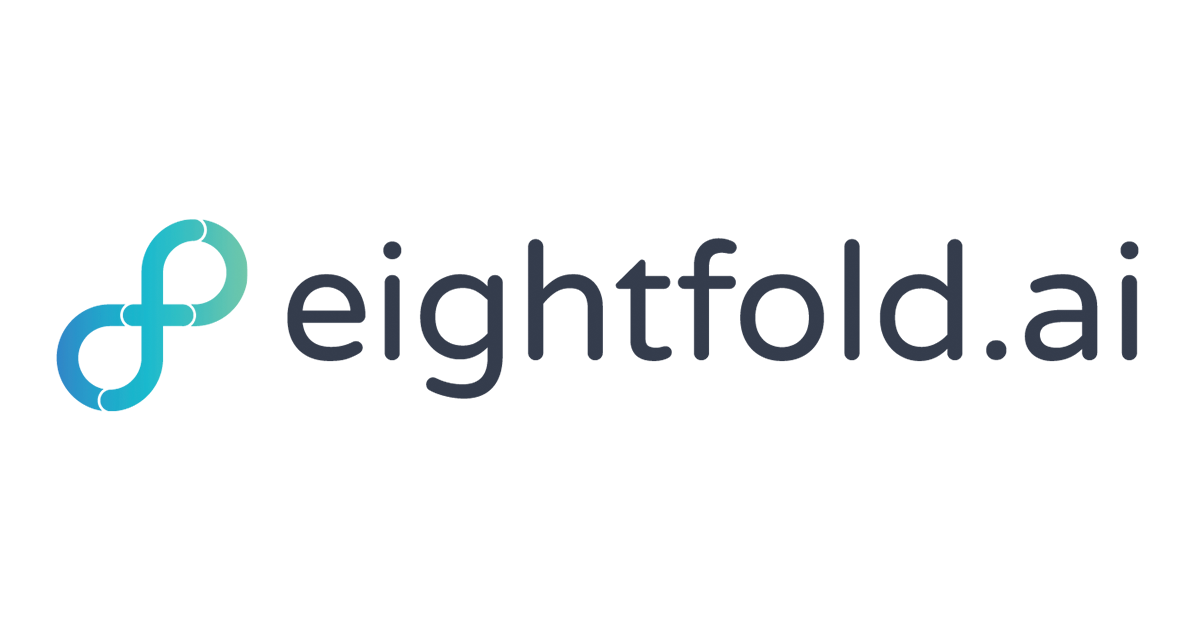 On November 4, I interviewed Kamal Ahluwalia, president of Eightfold AI, about how Eightfold's approach meets this challenge, and also how it provides guidance regarding training or coursework to assist veterans in adding skills that complement his or her military occupational specialties and so improve career outcomes.
On November 4, I interviewed Kamal Ahluwalia, president of Eightfold AI, about how Eightfold's approach meets this challenge, and also how it provides guidance regarding training or coursework to assist veterans in adding skills that complement his or her military occupational specialties and so improve career outcomes.
Introducing his company, Ahluwalia describes Eightfold AI as "an artificial intelligence company whose mission is to provide the right career to everyone in the world. To execute on this mission, we developed a capability matrix that allows us to predict fairly accurately what people are capable of doing. We are applying this to work on large talent pools so that we don't leave our mission on the wall. In the United States, veterans are over 6 percent of the workforce and that's over 20 million veterans in the country, although not all of them are in the workforce."
How does the program work?
"Our take on the Veterans' Challenge was twofold. First was how to address the spectrum of what the veterans want to do when they leave service; that has to be personalized, and they have a lot of choices. The military occupation fields are fairly esoteric, so we needed a mechanism to translate that to the civilian jobs. Second, we have to make it easy for veterans to use it without requiring too much hand-holding, and it has to be easy to understand so that the veterans can play with it on their own and so they can explore opportunities. There is one other aspect to the way we are developing the platform, and that is today we all should be in the habit of upskilling and reskilling all the time because skills get outdated in four to five years."
Profiling the veteran's capabilities and preferences
"The first step is that the veteran creates a profile by uploading their information so that the profile is as rich and as complete as possible. The platform shows the suggested roles that are available to them based on their current capabilities. In the example shown in Figure 1, those are civil engineer, structural design engineer, and environmental engineer. But in their preferences veterans can have their goals, which can be fairly different. So in the example you can see that this person's expressed interests are computer network architect, network systems admin, mechanical engineer. So these are two buckets we need to solve."
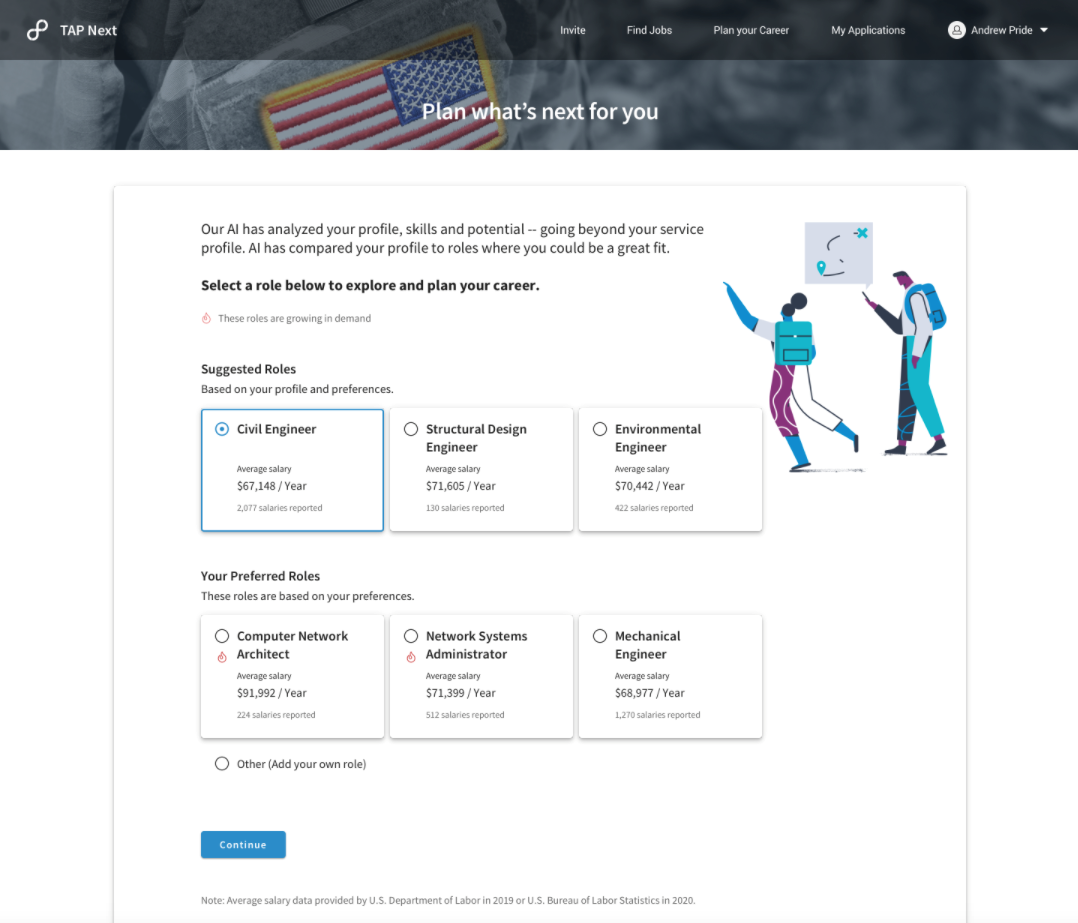
Figure 1: Plan what’s next for you
Exploring suggested roles and making connections
The next example that Ahluwalia showed me is the step where the veteran chooses to explore one of the suggested roles, civil engineer. (Figure 2)
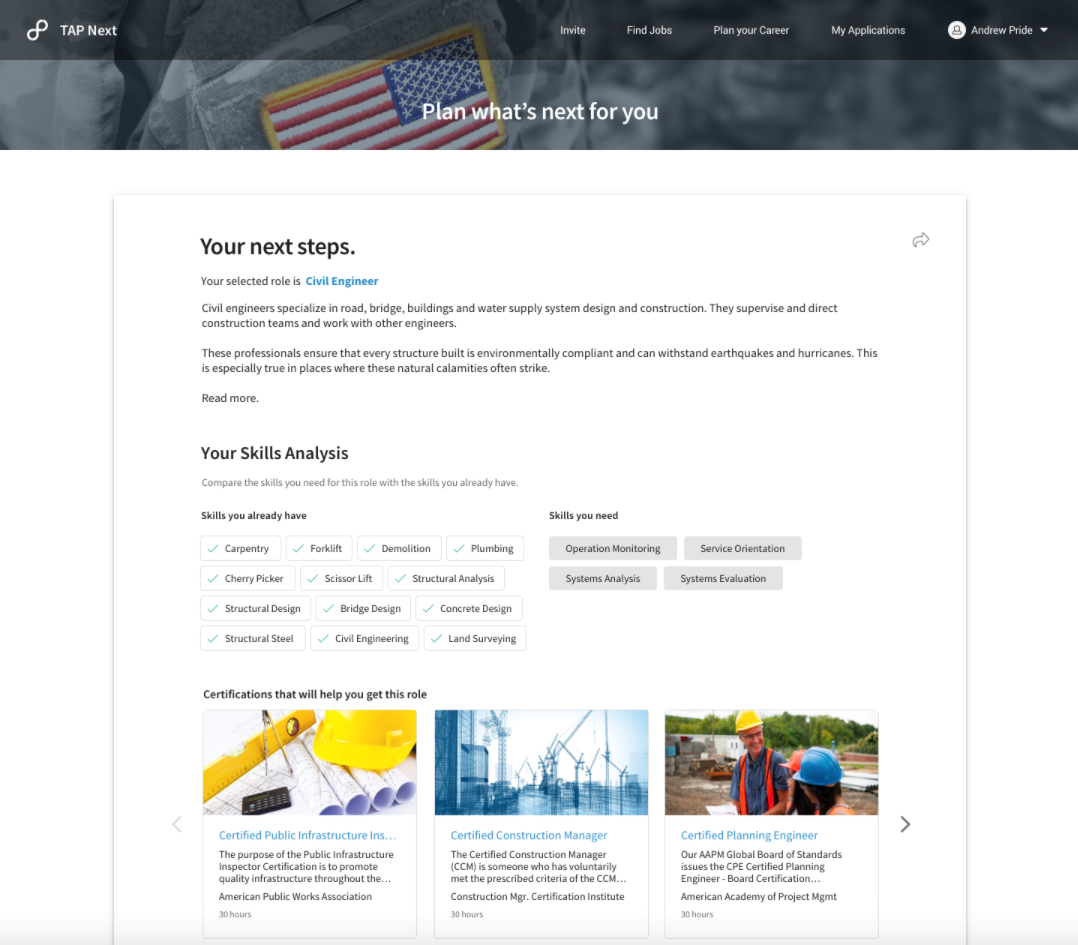
Figure 2: Your next steps
Ahluwalia says, "Based on our skills analysis, here are all the concrete things the veteran already knows, and the skills the veteran needs to develop to fulfill the selected role. These are the certifications that will help. The platform also gives the user examples of other veterans who did make a similar transition, so there is a level of confidence and if need be, we'll also connect them (Figure 3). At this point, we also provide additional opportunities and programs such as internships and Skill Bridge programs."
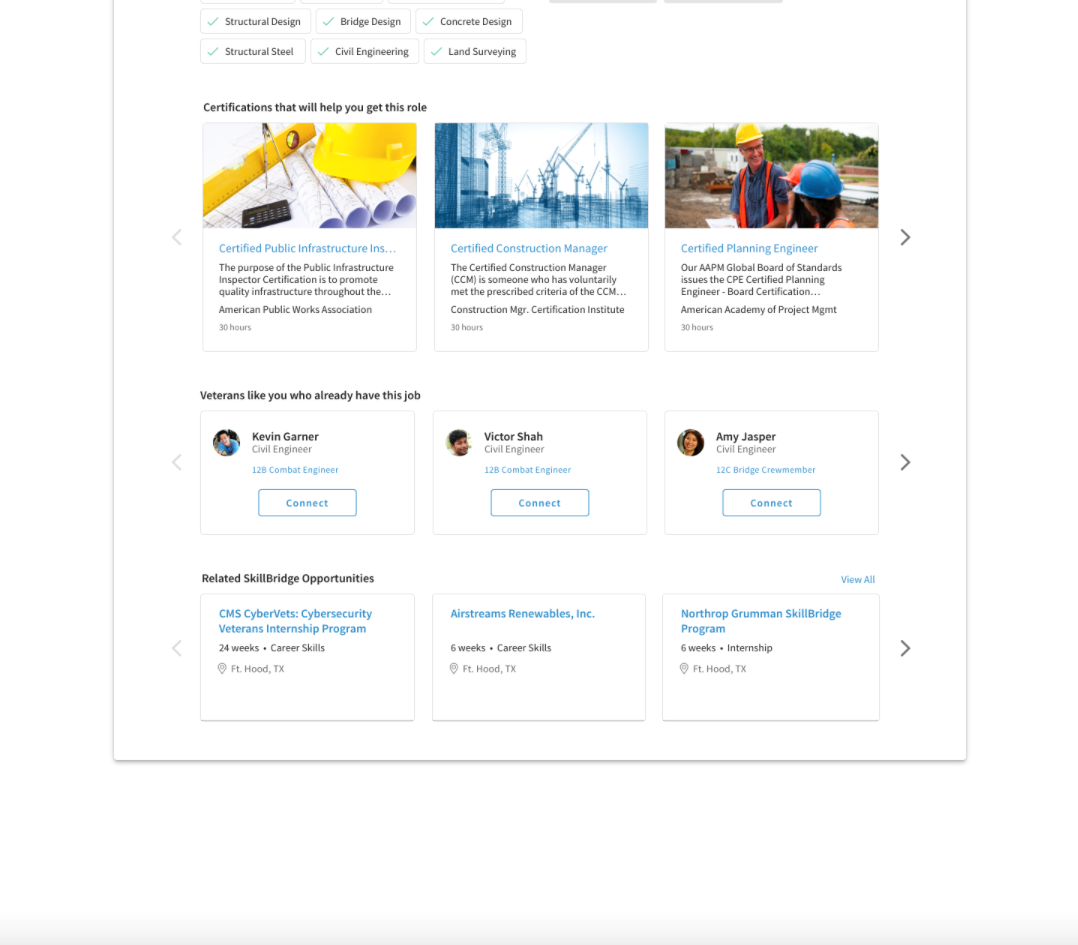
Figure 3: Certifications and connections
Four axioms
Ahluwalia continued, "Now the veteran can decide to make an investment of time to pursue one particular thing after weighing the possibilities against each other. Here is how we do this. There are two elements: understanding the job and understanding the capabilities of a person.
In the case of the job, we have four axioms. Number one is unfortunately that resumes are useless, and job descriptions are even worse. Trying to do a keyword Boolean search across the two in incomplete documents is useless. Second, people don't leave their current role to do the same thing in their next job, but we keep trying to pigeonhole people into the same route, which is why you have so much attrition even in good companies. Third, you cannot hire your way out of poor retention, so you have to take care of employees and give them more and more opportunities to grow within your organization. That alignment is often difficult to achieve. The fourth axiom is that while most of us are well-intentioned, we all bring our biases into the hiring decision. So with our algorithms, we don't take into account anything that would trigger the usual bias: sex, pedigree, ethnicity, anything like that. The matching is only on people's capabilities. (Figure 4).The result shown in this last example is also given to the employer to assist interviewers in understanding those capabilities. We are able to predict with over 90 percent accuracy the next two roles for an individual over the next five years. So when we are suggesting a role to a person, it is something that would be interesting to them because it's the next step forward. Not just, "Pat, you're a Salesforce admin, come become a Salesforce admin here" because that gets boring after a while. And this has 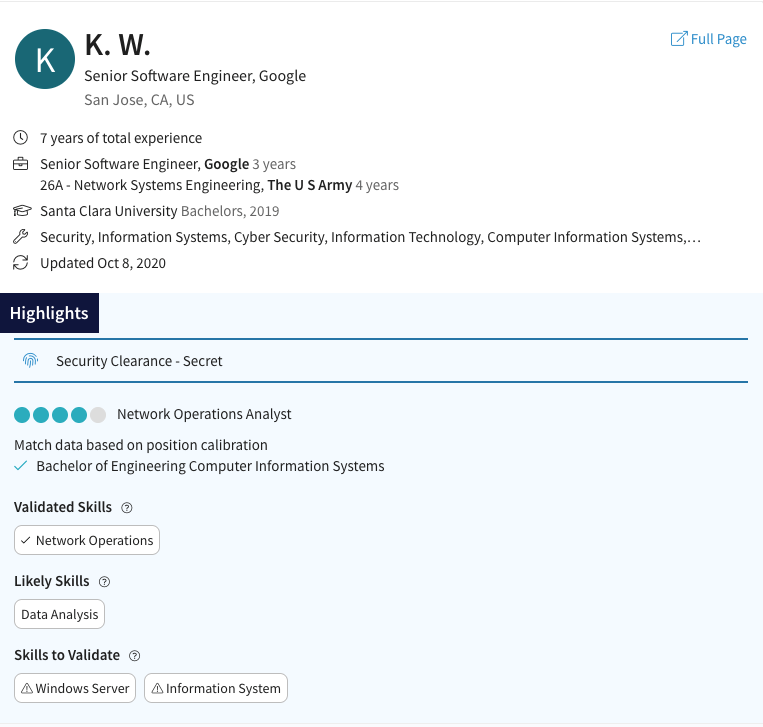
Figure 4: Matching without bias
Connecting the veteran to the possibilities
I asked how the Eightfold platform connects a veteran to one of these programs. Is it by a referral or some other way? "What the Department of Labor is planning on doing is that when the veteran is ready to transition, they go through a couple of days of orientation. We will be part of that curriculum," Ahluwalia said. "Help is available. They will retain access to the platform so that even when they're not in class they can play around with it and see, ‘Okay, what else is available to me?' And even on matching them to others who have done it, the same thing is that we can compare people, we can compare jobs, so that the more insights we give them, the better. And it's mostly information you can personalize—the three things we talk about: search, relevance, and personalization. Those things we are looking to apply for every veteran so that the path they pick is in line with what they want to do."
Getting access to the platform
I asked whether this will be available only to service members that are still on active duty, or is it available to people who are already veterans and have been looking for some time? Ahluwalia said, "It will be made available to everyone. They will need a DD214 or something like that to show their eligibility, for validation. But where we are going on this is to provide the right career for everyone. The focus is to make it easy for veterans so they can explore all. And a lot of us have skill gaps, so what is the veteran missing so that he or she is a good fit, because that helps employers also. Nobody wants a favor, and favor only comes once, but we want to make it easy for the veteran to continue to grow, and learning is part of it. So we'll always be available to the individual. The second part that we'll do on the jobsite with employers is help them put their jobs, calibrate them, so that they are clear and allow for better and better matching as you go forward. And the algorithms will learn from every interaction. That makes it easy."
When will the Department of Labor program be available?
Asked for the name given to the Eightfold AI platform as developed for veterans, Ahluwalia said that the Department of Labor has not named the project yet. The overall Eightfold platform is already available and in use in other fields. The Department of Labor is finalizing the timeline specific to the veteran's program. It is expected to be made available in early 2021 and will impact at least one million veteran careers over the next five years, according to Ahluwalia.



